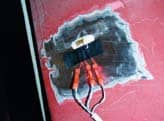Load testing on the Ponte della Costituzione in Venice
The Ponte della Costituzione is designed by the Spanish architect Santiago Calatrava and became the fourth bridge over the Grand Canal in Venice when it was inaugurated in September 2008. HBM Italy worked with Verona-based Veneta Engineering which was in charge of all optical height measurement and trigonometric leveling tests on the bridge, as well as determining the deformation and stress states needed for the acceptance inspection of the bridge in November 2007.
Veneta Engineering in Verona is one of the most important test and inspection companies in Italy for safety checks and European acceptance inspections. The company has been working in this field for more than 20 years and is highly regarded for the reliability and quality of its work.
The main structure that needed testing was designed as an arched truss comprising six cuboids over a total length of about 81 m. The load tests were performed with the bridge on its support pillars, without any temporary bridge abutments in the river bed and secured with lightly reinforced concrete. Four hydraulic pulling-lifting blocks were used, each with a mechanical load of 120 kN, as well as four tanks of 3.55 m x 15.85 m x 1.20 m, which were filled with 260 m3 of water in the central part of the bridge.
Stress analysis during the construction phase
Measurements were taken between ribs R14 and R14’ with an evenly distributed loading and at ribs R22 and R22’ with selective loading. This checked the actual longitudinal and transverse deformation of the bridge. The conformity between the computer model and the construction was also checked to verify the structure’s effective rigidity.
To capture the data around forty XY71-3/120 strain gages were installed with two measuring grids offset by 90°. The adhesive used was two-component X60 adhesive with a composite material with an aluminum layer, ABM 75, acting as the covering agent. Because of the length of the bridge, the measuring points were connected in a 6-wire circuit, which excluded measurement error as a result of voltage loss in the cables.
The MGCplus amplifier system with ML801 and AP815i modules were also used. Because of the high atmospheric humidity, the biggest challenge was choosing the right adhesives and protective materials, as well as laying the cables. The data was recorded for about a week by catman®Professional software and delivered excellent results.
